A Comparative Analysis of the Diets of a Genus of Freshwater Turtles across Africa
Abstract
1. Introduction
- (1)
- (2)
- Is there any effect of species, sex, or habitat (vegetation cover) on the diet composition of the various populations? This question is relevant because many studies have showed that there are considerable dietary variations associated with these variables in freshwater turtles [11].
- (3)
- Are there any ontogenetic dietary variations in the various species? More specifically, given that there are species that exhibit large sizes as adults but very small size at hatching (P. niger) and others that are very small even at the adult stage (P. nanus), is the ontogenetic dietary variation more pronounced in the larger than in the smaller species? This question is relevant because previous studies revealed that there are considerable dietary variations associated with body size and ontogenesis in turtles [12,13], whereas in modern reptiles, important ontogenetic dietary changes are generally linked to conspicuous variations in body size between juveniles and adults [14].
2. Materials and Methods
2.1. Data Sources and Field Protocol
2.2. Statistical Analyses
3. Results and Discussion
3.1. Diet Composition by Species
3.2. Effects of Vegetation Cover and Turtle Body Size
3.3. Effects of Sex and Ontogenetic Changes in the Diet Composition
4. Conclusions
Supplementary Materials
Author Contributions
Funding
Institutional Review Board Statement
Informed Consent Statement
Data Availability Statement
Acknowledgments
Conflicts of Interest
References
- Aresco, M.J.; Travis, J.; MacRae, P.S. Trophic interactions of turtles in a north Florida lake food web: Prevalence of omnivory. Copeia 2015, 103, 343–356. [Google Scholar] [CrossRef]
- Mccoy, C.J.; Flores-Villela, O.A.; Vogt, R.C.; Pappas, M.; McCoy, J.K. Ecology of riverine turtle communities in the southern United States: Food resource use and trophic niche dimensions. Chel. Cons. Biol. 2020, 19, 197–208. [Google Scholar]
- Lara, N.R.F.; Marques, T.S.; Montelo, K.M.; de Ataides, A.G.; Verdade, L.M.; Malvásio, A.; de Camargo, P.B. A trophic study of the sympatric Amazonian freshwater turtles Podocnemis unifilis and Podocnemis expansa (Testudines, Podocnemidae) using carbon and nitrogen stable isotope analyses. Can. J. Zool. 2012, 90, 1394–1401. [Google Scholar] [CrossRef]
- Balzani, P.; Vizzini, S.; Santini, G.; Masoni, A.; Ciofi, C.; Ricevuto, E.; Chelazzi, G. Stable isotope analysis of trophic niche in two co-occurring native and invasive terrapins, Emys orbicularis and Trachemys scripta elegans. Biol. Inv. 2016, 18, 3611–3621. [Google Scholar] [CrossRef]
- Ducotterd, C.; Crovadore, J.; Lefort, F.; Guisan, A.; Ursenbacher, S.; Rubin, J.F. The feeding behaviour of the European pond turtle (Emys orbicularis, L. 1758) is not a threat for other endangered species. Glob. Ecol. Conserv. 2020, 23, e01133. [Google Scholar] [CrossRef]
- Sung, Y.H.; Hau, B.C.; Karraker, N.E. Diet of the endangered big-headed turtle Platysternon megacephalum. Peer J. 2016, 4, e2784. [Google Scholar] [CrossRef]
- Luiselli, L. Food habits of the pelomedusid turtle Pelusios castaneus castaneus in southeastern Nigeria. Chel. Cons. Biol. 1998, 3, 106–107. [Google Scholar]
- Branch, B. Tortoises, Terrapins and Turtles of Africa; New Holland Publishing: Cape Town, South Africa, 2008. [Google Scholar]
- Luiselli, L.; Akani, G.C.; Politano, E.; Odegbune, E.; Bello, O. Dietary shifts of sympatric freshwater turtles in pristine and oil-polluted habitats of the Niger Delta, southern Nigeria. Herpetol. J. 2004, 14, 57–64. [Google Scholar]
- Ernst, C.H.; Altenburg, R.G.; Barbour, R.W. Turtles of the World; Smithsonian Press: Washington, DC, USA, 1998. [Google Scholar]
- McCauley, S.J.; Bjorndal, K.A. Response to dietary dilution in an omnivorous freshwater turtle: Implications for ontogenetic dietary shifts. Physiol. Biochem. Zool. 1999, 72, 101–108. [Google Scholar] [CrossRef]
- Bouchard, S.S.; Bjorndal, K.A. Ontogenetic diet shifts and digestive constraints in the omnivorous freshwater turtle Trachemys scripta. Physiol. Biochem. Zool. 2006, 79, 150–158. [Google Scholar] [CrossRef]
- Claude, J.; Pritchard, P.H.; Tong, H.; Paradis, E.; Auffray, J.-C. Ecological Correlates and Evolutionary Divergence in the Skull of Turtles: A Geometric Morphometric Assessment. Syst. Biol. 2004, 53, 933–948. [Google Scholar] [CrossRef]
- Burke, R.L.; Luiselli, L. Ontogenetic niche shifts: Modern reptiles change diets with age too. Science 2021, 371, 941–944. [Google Scholar]
- Luiselli, L.; Akani, G.C.; Ajong, S.N.; George, A.; Di Vittorio, M.; Eniang, E.A.; Dendi, D.; Hema, E.M.; Petrozzi, F.; Fa, J.E. Predicting the structure of turtle assemblages along a megatransect in West Africa. Biol. J. Linn. Soc. 2020, 130, 296–309. [Google Scholar] [CrossRef]
- Luiselli, L.; Amori, G. Diet. In Reptile Ecology and Conservation: A Handbook of Techniques; Dodd, C.K., Jr., Ed.; Oxford University Press: Oxford, UK, 2016; pp. 97–109. [Google Scholar]
- Hosmer, D.W.; Lemeshow, S. Applied Logistic Regression Analysis, 2nd ed.; John Wiley and Sons: New York, NY, USA, 2000. [Google Scholar]
- McCullagh, P.; Nelder, J.A. Generalized Linear Models; Chapman and Hall/CRC: London, UK, 1989. [Google Scholar]
- Shine, R. Intersexual dietary divergence and the evolution of sexual dimorphism in snakes. Am. Nat. 1991, 138, 103–122. [Google Scholar] [CrossRef]
- Houston, D.; Shine, R. Sexual dimorphism and niche divergence: Feeding habits of the Arafura filesnake. J. Anim. Ecol. 1993, 62, 737–748. [Google Scholar] [CrossRef]
- Shine, R.; Harlow, P.S.; Keogh, J.S. The influence of sex and body size on food habits of a giant tropical snake, Python reticulatus. Funct. Ecol. 1998, 12, 248–258. [Google Scholar] [CrossRef]
- Gerlach, J.; Rhodin, A.G.J.; Pritchard, P.C.H.; van Dijk, P.P.; Saumure, R.A.; Buhlmann, K.A.; Iverson, J.B. Pelusios subniger parietalis Bour 1983–Seychelles black mud turtle. In Conservation Biology of Freshwater Turtles and Tortoises: A Compilation Project of the IUCN/SSC Tortoise and Freshwater Turtle Specialist Group; Chelonian Research Foundation: Lunenburg, MA, USA, 2008. [Google Scholar]
- Ceballos, C.P.; Adams, D.C.; Iverson, J.B.; Valenzuela, N. Phylogenetic patterns of sexual size dimorphism in turtles and their implications for Rensch’s Rule. Evol. Biol. 2013, 40, 194–208. [Google Scholar] [CrossRef]
- Tucker, A.D.; Fitzsimmons, N.N.; Gibbons, J.W. Resource partitioning by the estuarine turtle Malaclemys terrapin: Trophic, spatial, and temporal foraging constraints. Herpetologica 1995, 51, 167–181. [Google Scholar]
- Bulté, G.; Gravel, M.A.; Blouin-Demers, G. Intersexual niche divergence in northern map turtles (Graptemys geographica): The roles of diet and habitat. Can. J. Zool. 2008, 86, 1235–1243. [Google Scholar] [CrossRef]
- Herrel, A.; O’Reilly, J.C. Ontogenetic scaling of bite force in lizards and turtles. Physiol. Bioch. Zool. 2006, 79, 31–42. [Google Scholar] [CrossRef]
- Bulté, G.; Irschick, D.J.; Blouin-Demers, G. The reproductive role hypothesis explains trophic morphology dimorphism in the northern map turtle. Funct. Ecol. 2008, 22, 824–830. [Google Scholar] [CrossRef]
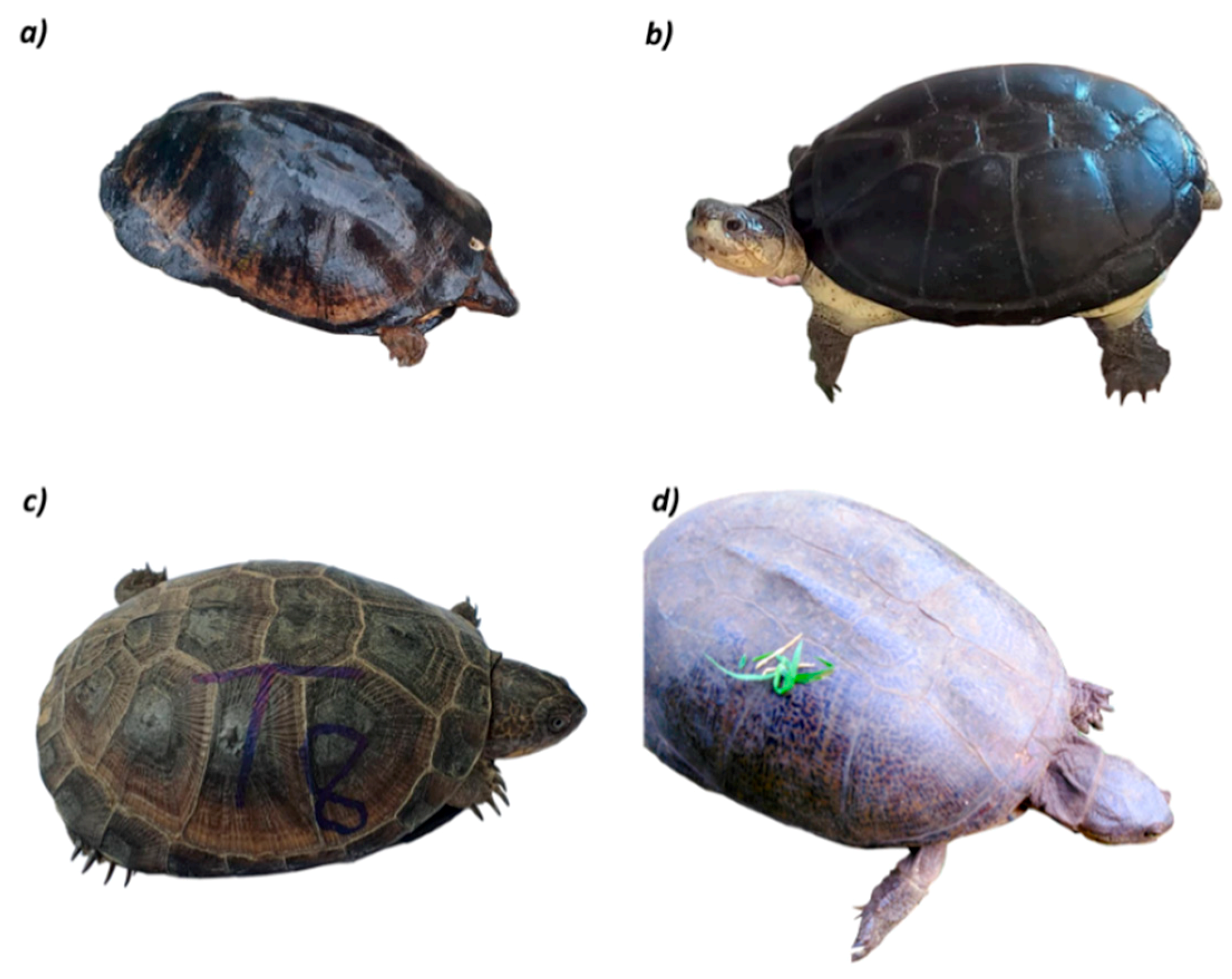
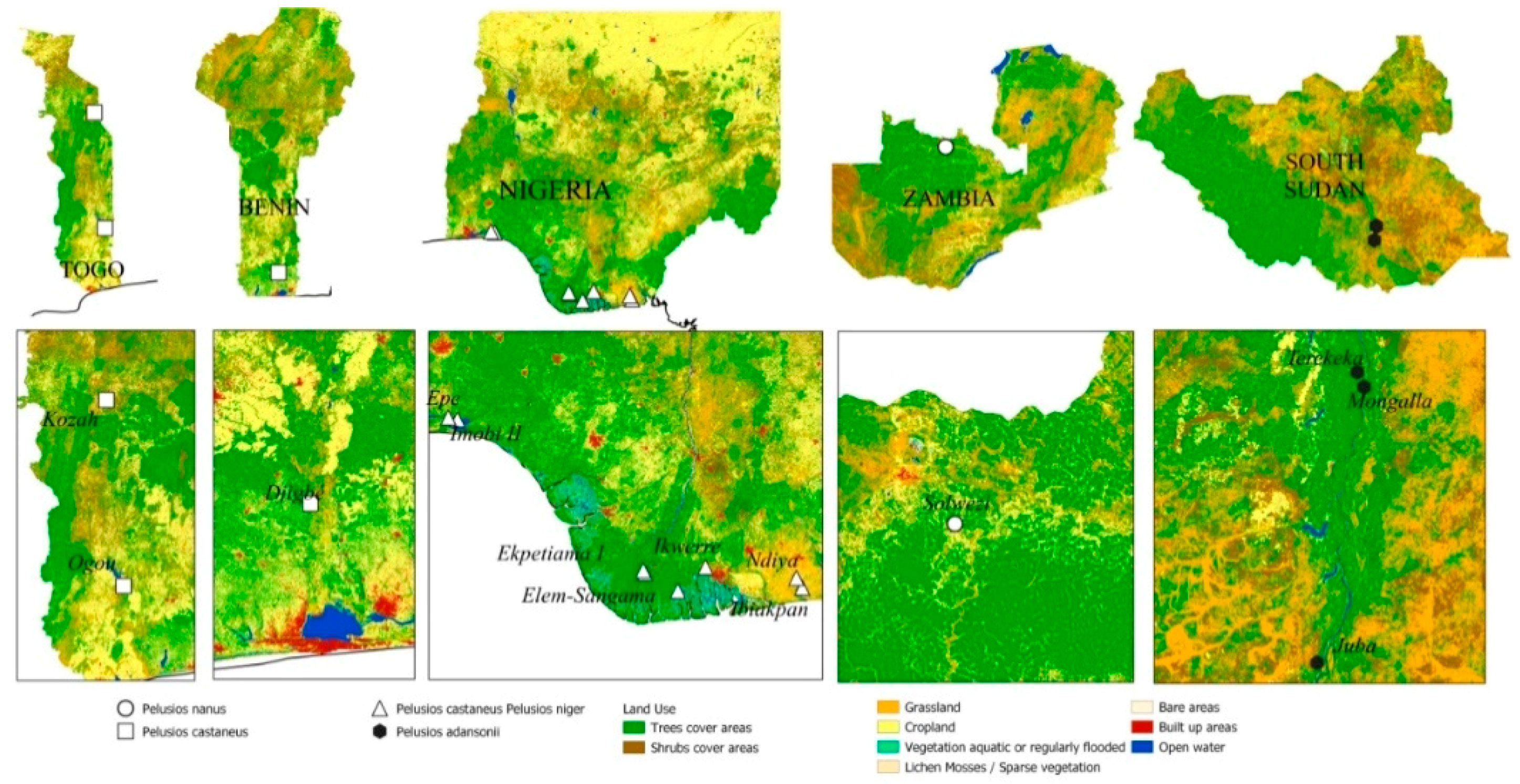
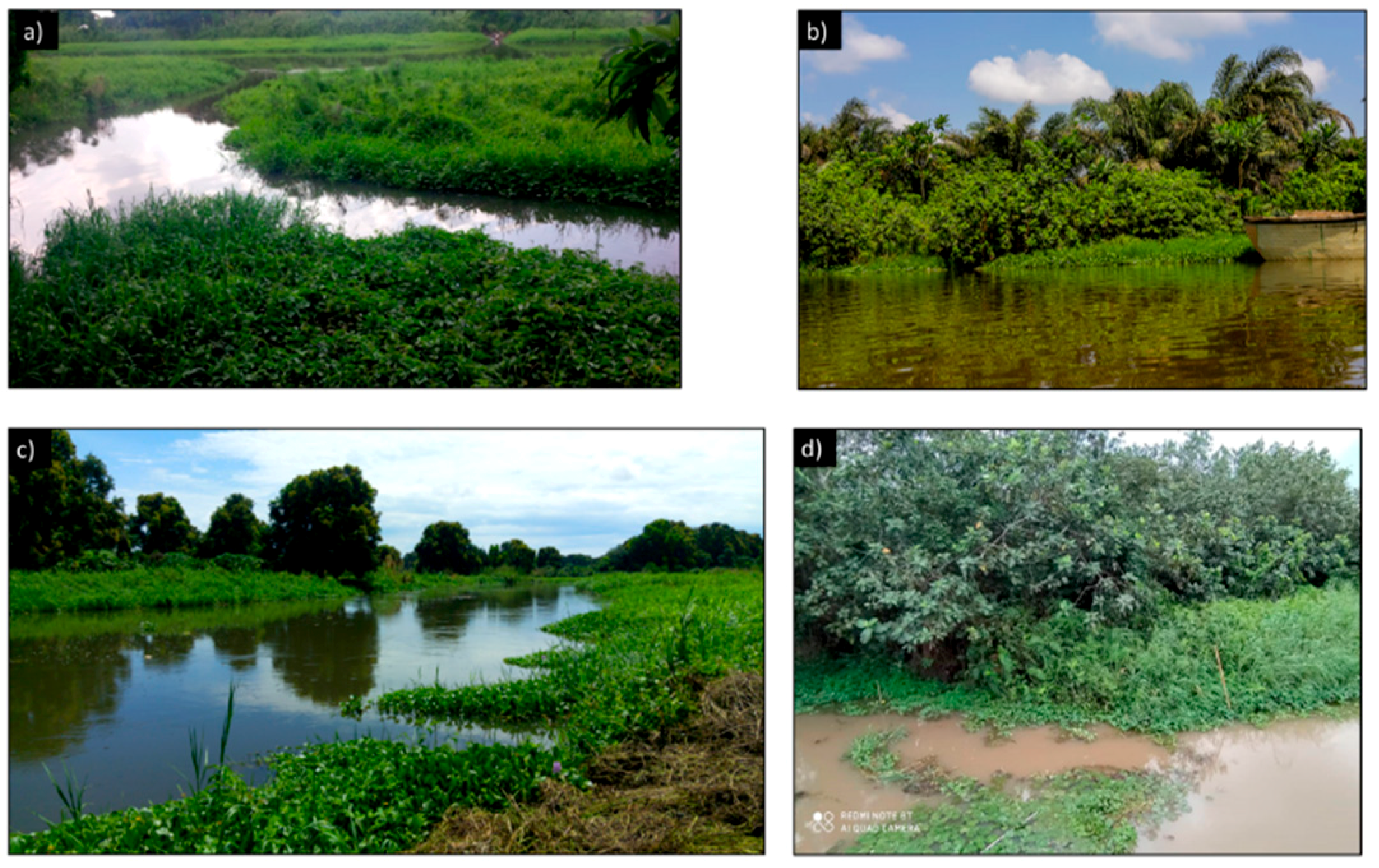

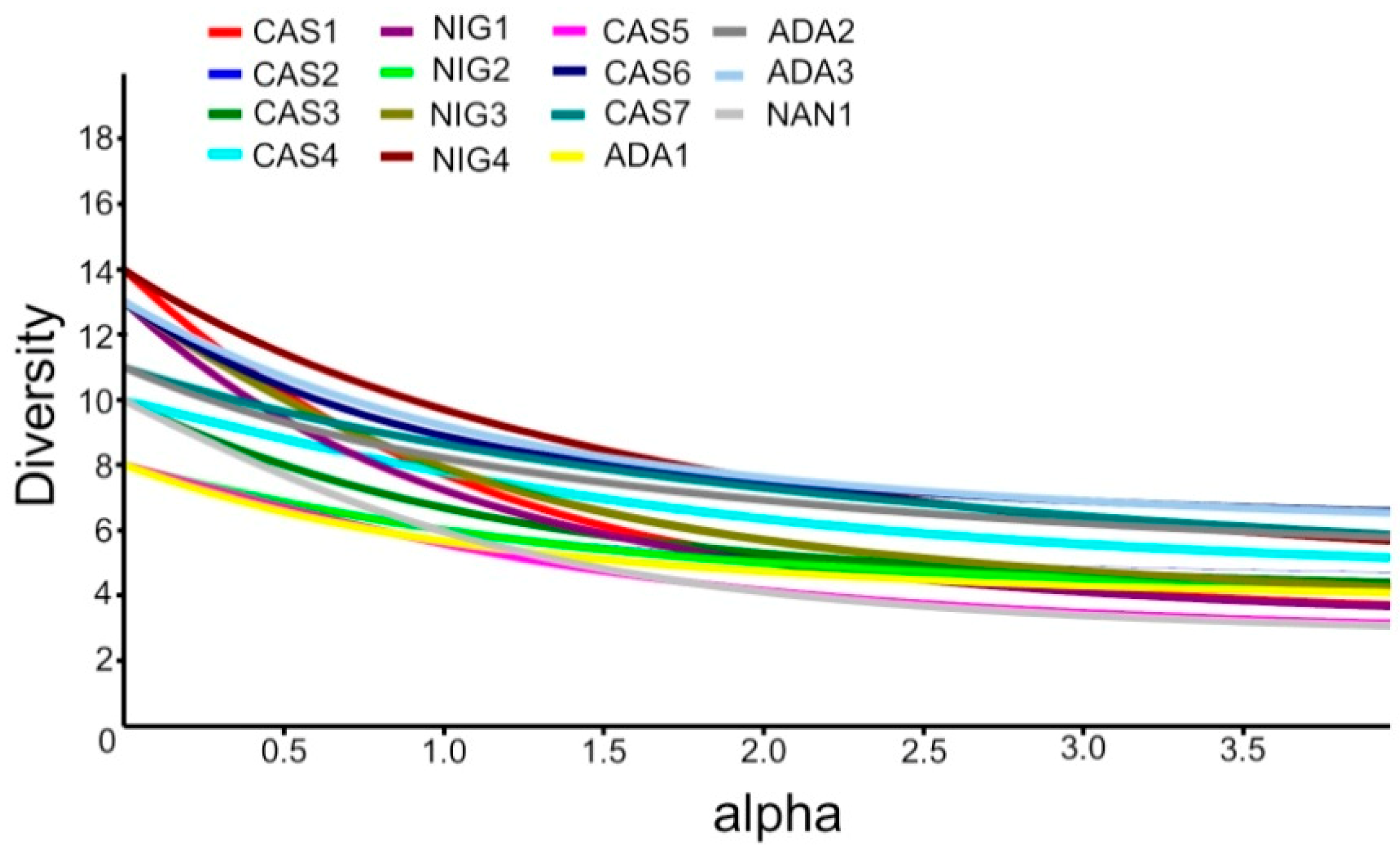
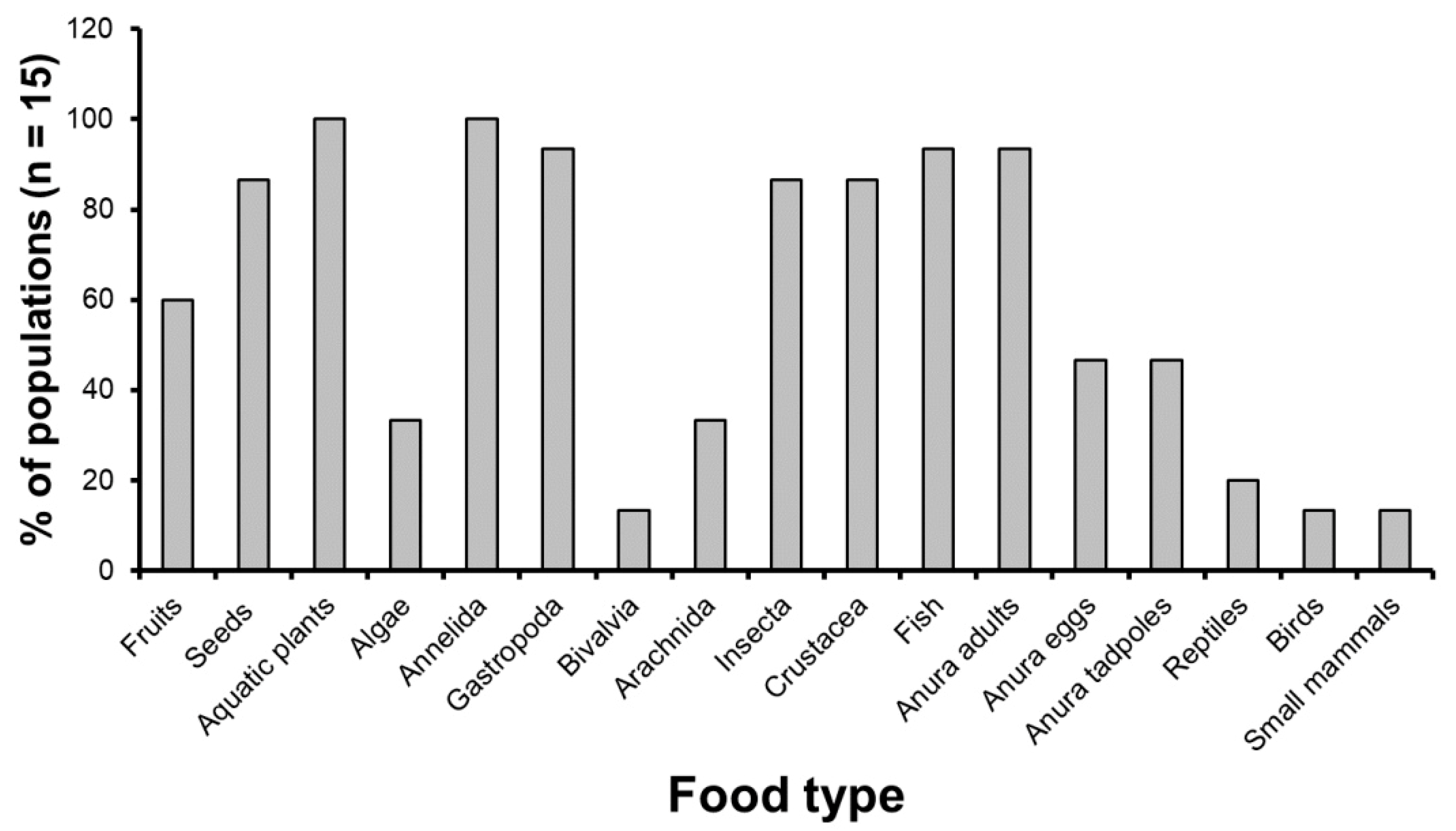
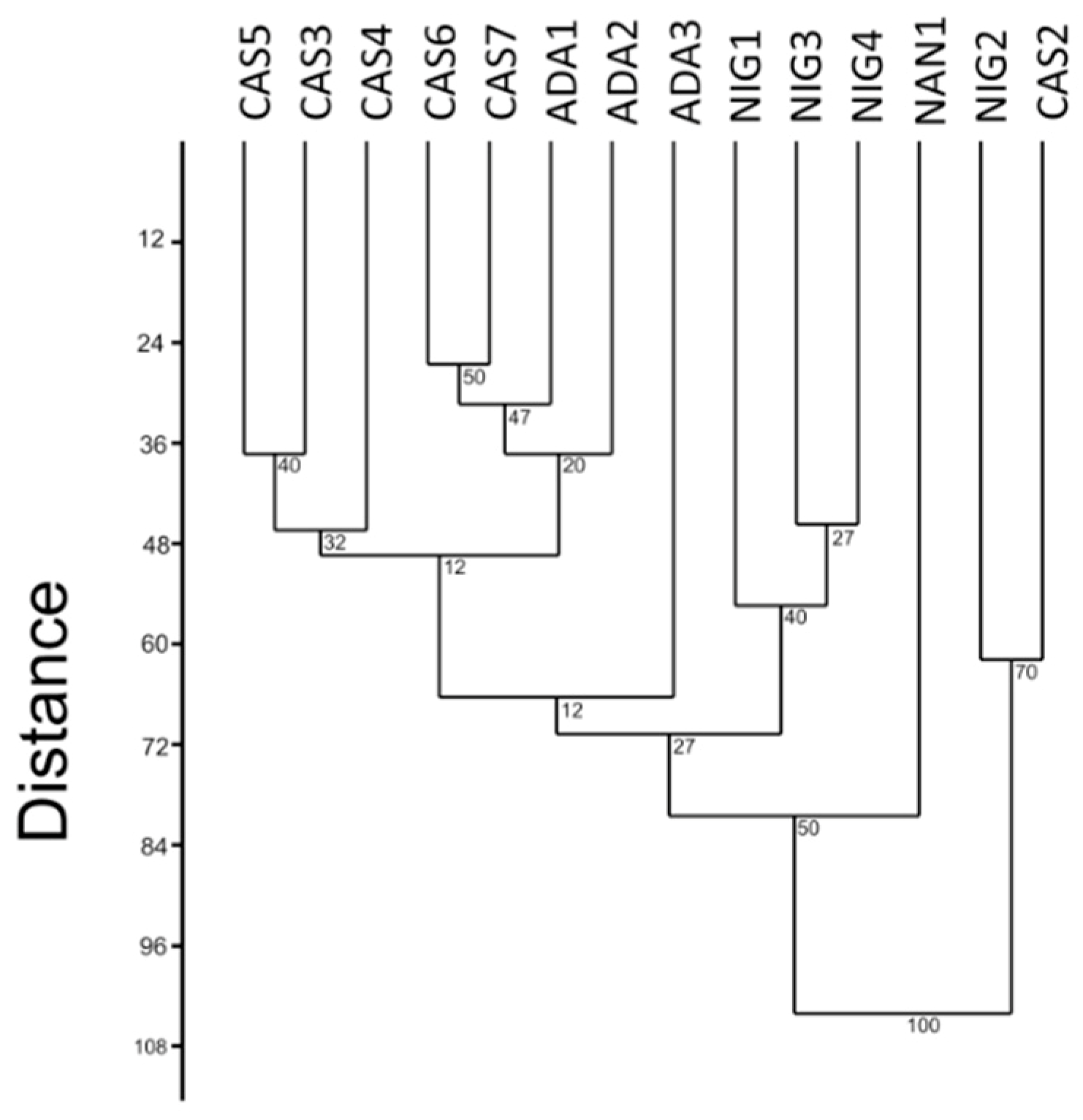
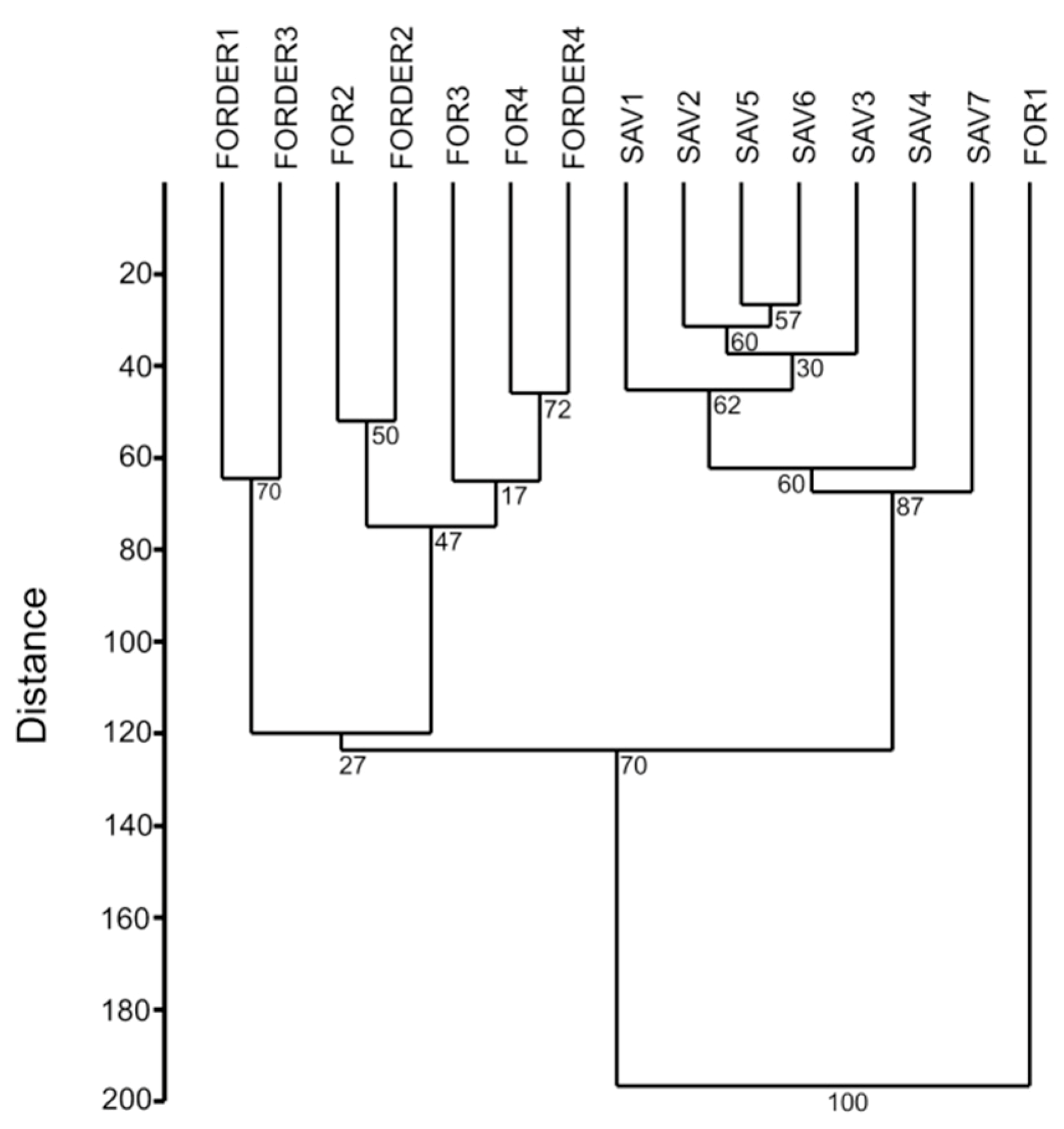
| Nigeria | Nigeria | Nigeria | Nigeria | Benin | Togo | Togo | Nigeria | Nigeria | Nigeria | Nigeria | South Sudan | South Sudan | South Sudan | Zambia | |
|---|---|---|---|---|---|---|---|---|---|---|---|---|---|---|---|
| Forest | For-Derived | Forest | For-Derived | Savannah | Savannah | Savannah | Forest | For-Derived | Forest | For-Derived | Savannah | Savannah | Forest | Savannah | |
| castaneus | castaneus | castaneus | castaneus | castaneus | castaneus | castaneus | niger | niger | niger | niger | adansonii | adansonii | adansonii | nanus | |
| N | 217 | 21 | 65 | 92 | 56 | 135 | 82 | 113 | 39 | 77 | 81 | 133 | 41 | 39 | 69 |
| Fruits | 5.1 | 19 | 5 | 7 | 0 | 2.22 | 0 | 7.1 | 7.7 | 0 | 0 | 0 | 2.44 | 5.13 | 0 |
| Seeds | 3.7 | 76.2 | 10.3 | 15.9 | 5.37 | 15.56 | 13.4 | 3.3 | 30.8 | 5.2 | 0 | 0 | 7.32 | 10.26 | 7.25 |
| Aquatic plants | 7.4 | 66.7 | 52.8 | 38.5 | 55.3 | 25.19 | 20.7 | 7.9 | 33.3 | 27.3 | 16.0 | 30.8 | 43.9 | 38.5 | 8.7 |
| Algae | 0 | 0 | 1.4 | 6.6 | 0 | 2.96 | 0.0 | 0 | 0 | 3.9 | 13.6 | 0 | 0.00 | 0.00 | 0.00 |
| Annelida | 3.7 | 42.9 | 8.3 | 4.9 | 12.5 | 12.59 | 19.5 | 10.6 | 61.5 | 6.5 | 7.4 | 12.8 | 19.5 | 46.2 | 17.4 |
| Gastropoda | 5.1 | 57.1 | 29.2 | 36.1 | 0 | 4.44 | 15.9 | 3.5 | 69.2 | 6.5 | 25.9 | 1.5 | 19.5 | 10.3 | 4.3 |
| Bivalvia | 0.9 | 0 | 0 | 0 | 0 | 0.00 | 0.0 | 0 | 0 | 0.0 | 1.2 | 0.0 | 0.0 | 0.0 | 0.0 |
| Arachnida | 2.8 | 0 | 0 | 0 | 0 | 0.74 | 0.0 | 2.6 | 0 | 0.0 | 0.0 | 0.0 | 0.0 | 2.6 | 30.4 |
| Insecta | 6 | 0 | 12.5 | 10.6 | 12.5 | 31.85 | 43.9 | 0.9 | 0 | 27.3 | 30.9 | 30.8 | 51.2 | 43.6 | 68.1 |
| Crustacea | 18.9 | 0 | 11.1 | 9 | 10.71 | 8.89 | 2.4 | 23.9 | 0 | 42.9 | 13.6 | 4.5 | 14.6 | 53.8 | 2.9 |
| Fish | 52.5 | 14.3 | 45.8 | 7.4 | 25 | 30.37 | 14.6 | 69.9 | 12.8 | 80.5 | 58.0 | 15.8 | 31.7 | 20.5 | 0.0 |
| Anura adults | 3.7 | 4.8 | 5.6 | 18 | 5.37 | 24.44 | 25.6 | 12.4 | 10.2 | 20.8 | 23.5 | 7.5 | 14.6 | 15.4 | 0.0 |
| Anura eggs | 9.2 | 0 | 0 | 0 | 0 | 4.44 | 8.5 | 15 | 0 | 0.0 | 7.4 | 0.0 | 2.4 | 0.0 | 4.3 |
| Anura tadpoles | 22.6 | 9.5 | 0 | 0 | 0 | 0.00 | 6.1 | 29.2 | 10.2 | 0.0 | 0.0 | 0.0 | 0.0 | 10.3 | 10.1 |
| Reptiles | 0 | 0 | 0 | 0 | 0 | 0 | 0.0 | 0 | 0 | 3.9 | 1.2 | 0.0 | 0.0 | 2.6 | 0.0 |
| Birds | 0 | 0 | 0 | 0 | 0 | 0 | 0.0 | 0 | 0 | 9.1 | 6.2 | 0.0 | 0.0 | 0.0 | 0.0 |
| Small mammals | 0 | 0 | 0 | 0 | 0 | 0 | 0.0 | 0 | 0 | 7.8 | 9.9 | 0.0 | 0.0 | 0.0 | 0.0 |
| Indeterminate | 0.4 | 0 | 0 | 0 | 5.36 | 2.96 | 3.7 | 0.9 | 0 | 3.9 | 6.2 | 3.0 | 12.2 | 10.3 | 5.8 |
| Estimate | St. Error | Wald | p | |
|---|---|---|---|---|
| Anura tadpoles | 0.035197 | 0.009961 | 12.48426 | 0.000410 |
| Anura adults | −0.13081 | 0.019494 | 45.02788 | 0.000000 |
| Fish | 0.009662 | 0.002308 | 17.52001 | 0.000028 |
| Reptiles | 0.274646 | 0.056558 | 23.58069 | 0.000001 |
| Birds | 0.210985 | 0.025179 | 70.21284 | 0.000000 |
| Estimate | St. Error | Wald | p | |
|---|---|---|---|---|
| Algae | 0.112020 | 0.009507 | 138.8375 | 0.000000 |
| Bivalvia | 1.514130 | 0.231157 | 42.90536 | 0.000000 |
| Arachnida | −0.060554 | 0.015102 | 16.0784 | 0.000061 |
| Reptiles | 0.389812 | 0.000062 | 38,937,600 | 0.000000 |
| Birds | 0.098272 | 0.032757 | 9.00000 | 0.002700 |
| Small mammals | 0.084896 | 0.028299 | 9.00000 | 0.002700 |
| Species | Country | No. Males | No. Females | χ2 | df | p |
|---|---|---|---|---|---|---|
| P. castaneus | Nigeria | 211 | 178 | 19.3 | 13 | 0.113 |
| P. castaneus | Benin | 27 | 29 | 5.6 | 7 | 0.590 |
| P. castaneus | Togo | 103 | 114 | 6.4 | 13 | 0.929 |
| P. niger | Nigeria | 162 | 148 | 22.2 | 16 | 0.136 |
| P. adansonii | South Sudan | 122 | 91 | 15.8 | 13 | 0.262 |
| P. nanus | Zambia | 30 | 39 | 8.4 | 9 | 0.494 |
| Species | <8 cm (N) | 8–14 cm (N) | >14 cm (N) | χ2 | df | p |
|---|---|---|---|---|---|---|
| P. castaneus | 158 | 389 | 121 | 426.3 | 28 | <0.0001 |
| P. niger | 99 | 101 | 110 | 162.5 | 34 | <0.0001 |
| P. adansonii | 58 | 122 | 33 | 94.3 | 26 | <0.0001 |
| P. nanus | 31 | 38 | not available | 11.25 | 9 | 0.259 |
Publisher’s Note: MDPI stays neutral with regard to jurisdictional claims in published maps and institutional affiliations. |
© 2021 by the authors. Licensee MDPI, Basel, Switzerland. This article is an open access article distributed under the terms and conditions of the Creative Commons Attribution (CC BY) license (https://creativecommons.org/licenses/by/4.0/).
Share and Cite
Luiselli, L.; Demaya, G.S.; Benansio, J.S.; Petrozzi, F.; Akani, G.C.; Eniang, E.A.; Ajong, S.N.; Di Vittorio, M.; Amadi, N.; Dendi, D. A Comparative Analysis of the Diets of a Genus of Freshwater Turtles across Africa. Diversity 2021, 13, 165. https://doi.org/10.3390/d13040165
Luiselli L, Demaya GS, Benansio JS, Petrozzi F, Akani GC, Eniang EA, Ajong SN, Di Vittorio M, Amadi N, Dendi D. A Comparative Analysis of the Diets of a Genus of Freshwater Turtles across Africa. Diversity. 2021; 13(4):165. https://doi.org/10.3390/d13040165
Chicago/Turabian StyleLuiselli, Luca, Gift Simon Demaya, John Sebit Benansio, Fabio Petrozzi, Godfrey C. Akani, Edem A. Eniang, Stephanie N. Ajong, Massimiliano Di Vittorio, NioKing Amadi, and Daniele Dendi. 2021. "A Comparative Analysis of the Diets of a Genus of Freshwater Turtles across Africa" Diversity 13, no. 4: 165. https://doi.org/10.3390/d13040165
APA StyleLuiselli, L., Demaya, G. S., Benansio, J. S., Petrozzi, F., Akani, G. C., Eniang, E. A., Ajong, S. N., Di Vittorio, M., Amadi, N., & Dendi, D. (2021). A Comparative Analysis of the Diets of a Genus of Freshwater Turtles across Africa. Diversity, 13(4), 165. https://doi.org/10.3390/d13040165








